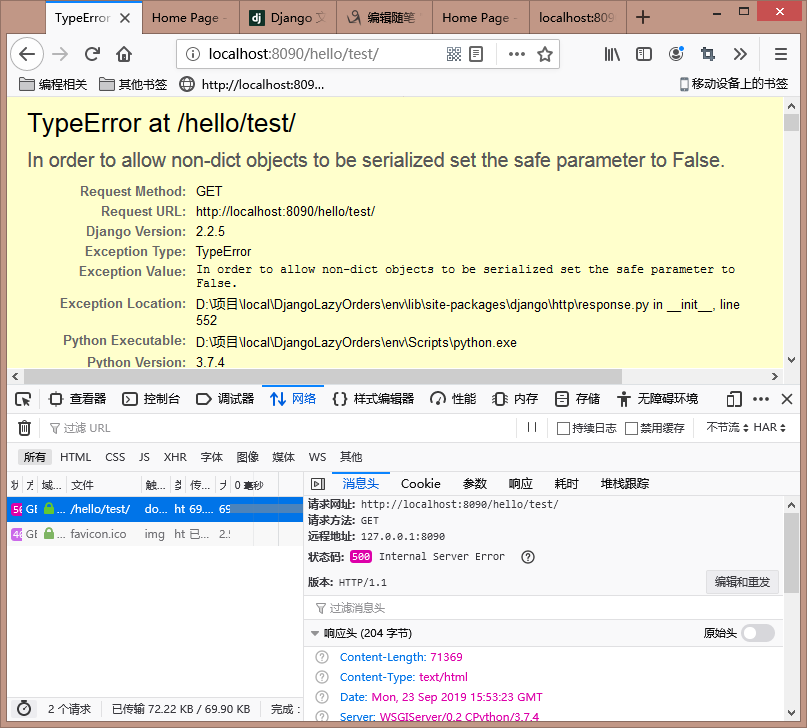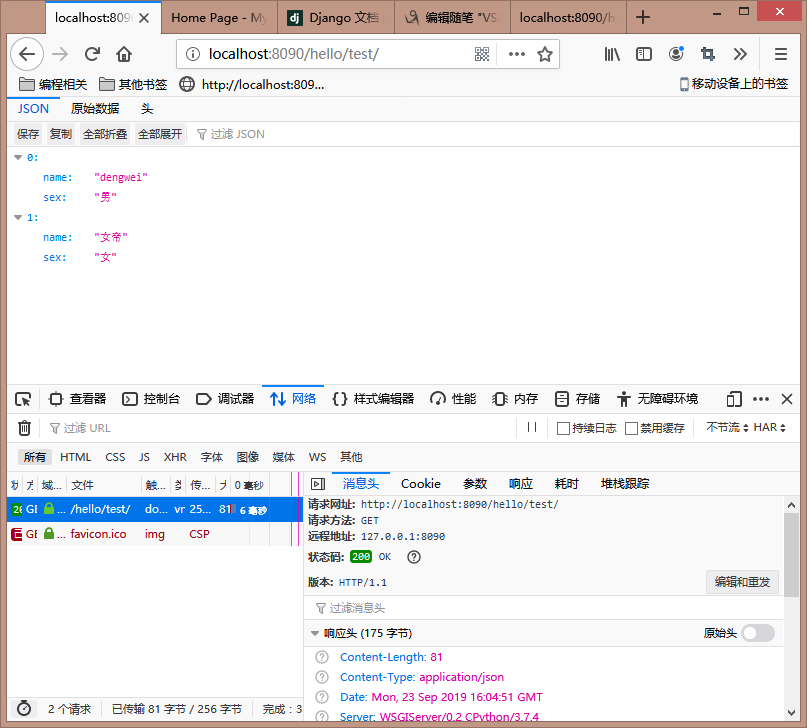这几天学习了一下Django的视图和模板,从这几天的学习进度来看,视图这里并没有花很多的时间,相反的,模板花费了大量的时间,主要原因还是因为对Jquery操作dom不熟练,其次就是对bootstrap的使用不熟练,所以花了一些时间研究官方文档。
那么,言归正传,先从视图(views.py)开始讲起。Django中视图与其他框架中的视图(尤其是MVC模式)不一样,Django中的视图,用Asp.Net Mvc框架来类比的话,就是Controller,里边的视图函数就是Action,这个在第二篇博文中介绍文件目录结构的时候有提到过,那么我们的请求,要到达一个Controller,然后到达一个Action,需要一个路由表,Django中也是有类似的设计的,只是换了个说法,叫做URL调度器,具体的用法我们可以查看官方文档,文档中会介绍很多的匹配规则,复杂的可以使用正则表达式来配置匹配规则,但是经验告诉我,这个路由规则还是尽可能简洁明了的好,因为如果不是开放给第三方的Api的话,用这个规则的终究是自己,反过来,就算是开放给第三方的Api,搞得太复杂也会让人诟病。当然这只是我的个人见解......
接下来,就到了直接上代码的时候了,看DjangoLazyOrders这个项目中,我的URL配置是怎么配置的:分为两部分,一个是整个应用的URL配置,一个是hello这个App的URL配置,着重看着色部分代码。
#D:项目localDjangoLazyOrdersDjangoLazyOrdersurls.py urlpatterns = [path('', views.home, name='home'), path('contact/', views.contact, name='contact'), path('about/', views.about, name='about'), path('login/', LoginView.as_view(template_name='app/login.html', authentication_form=forms.BootstrapAuthenticationForm, extra_context= { 'title': 'Log in', 'year' : datetime.now().year, }), name='login'), path('logout/', LogoutView.as_view(next_page='/'), name='logout'), path('admin/', admin.site.urls), path('hello/', include('hello.urls')),]
from django.urls import path,include from hello import views #D:项目localDjangoLazyOrdershellourls.py urlpatterns = [path('hello/',views.hello,name='hello'), path('test/',views.test,name='test'), path('lazy_orders_index/',views.lazy_orders_index,name='lazy_orders_index'), path('<int:category_id>/category/', include([path('delete/', views.category_delete,name='category_delete'),path('edit/', views.category_edit,name='category_edit')]))]
那么,以上代码代表的规则是什么呢?
1)hellourls.py中的配置一共展示了有三个视图,分别是lazy_orders_index,category_delete,category_edit,那么,这三个视图分别对应的视图函数该怎么定义呢?直接看代码(部分代码未实现完整):
- lazy_orders_index 参数request是必须带的,所有的视图函数第一个参数永远是request,因为第一个路由规则没有配置参数,所以只有这个默认的参数
- category_delete,category_edity有一个公共部分<int:category_id>,删除和编辑需要提供一个参数category_id,所以把公共部分提取出来放到前面,然后再各自匹配各自的规则,delete与edit
import json from datetime import datetime from django.core import serializers from django.shortcuts import render from django.http import HttpResponse,JsonResponse from hello.models import Category,Menu # Create your views here. def hello(request): return HttpResponse("hello world!") def test(request): return HttpResponse("test") def category_edit(request,category_id): return HttpResponse("edit") def lazy_orders_index(request): categorys = Category.objects.all()#查询所有的类别 menus = Menu.objects.all()#查询所有的菜单 json_categorys = []#定义两个数组 用来保存model的json数据 json_menus = [] for category in categorys: json_categorys.append({ "category_id":category.category_id, "category_name":category.category_name#遍历实体对象 构建ViewModel的数据 }) for menu in menus: json_menus.append({ "category_name":menu.category.category_name, "menu_name":menu.menu_name }) context = {'json_categorys': json.dumps(json_categorys),'json_menus':json.dumps(json_menus),'categorys':categorys,'menus':menus,'year':datetime.now().year} return render(request,'hello/lazyorders.cshtml',context)#将数据和模板传给render函数 渲染成html返回给客户端 def category_delete(request,category_id): Category.objects.get(pk=category_id).delete() return JsonResponse({'code':0,'message':'ok'})
- render(),将给定的模板与给定的上下文字典组合在一起,并以渲染的文本返回一个
HttpResponse对象。通俗一点就是将一个request对象,以及指定的模板,和模板中使用到的数据传递给这个函数,函数会将模板渲染成标准的html文本,然后返回给浏览器。 - redirect(),将一个
HttpResponseRedirect返回到传递的参数的适当URL。通俗一点就是跳转到指定的URL。
我们在上面的View中已经使用到了render()函数,模板指定的是hello App下的lazyOrders.cshtml文件(后缀之所以为.cshtml上一篇已经做了解释),数据对象context,context中我既给了直接从数据库中查出来的实体对象,又封装了一个ViewModel的json数据传给了模板,为什么要这么做呢?是因为我要在模板中实现两套逻辑,下一篇模板相关的内容会做详细的介绍,这里只是提一下。
3)JsonResponse()
- 要返回Json数据给前端,可以使用HttpResponse,然后指定content-type为application/json即可,示例代码如下:
def test(request): data = { 'name': 'dengwei', 'sex': '男' } return HttpResponse(json.dumps(data),content_type="application/json")

- 除了使用上述方法,Django还提供了一个更方便的http响应类,JsonResponse,查看这个类的源代码可以知道,继承自HttpResponse,并且在内部对数据调用了json.dumps()序列化,同时还发现,这个类要求序列化的对象必须是dict类型对象,如果要序列化非dict的对象,必须传递参数safe为false,默认为true
class JsonResponse(HttpResponse): """ An HTTP response class that consumes data to be serialized to JSON. :param data: Data to be dumped into json. By default only ``dict`` objects are allowed to be passed due to a security flaw before EcmaScript 5. See the ``safe`` parameter for more information. :param encoder: Should be a json encoder class. Defaults to ``django.core.serializers.json.DjangoJSONEncoder``. :param safe: Controls if only ``dict`` objects may be serialized. Defaults to ``True``. :param json_dumps_params: A dictionary of kwargs passed to json.dumps(). """ def __init__(self, data, encoder=DjangoJSONEncoder, safe=True, json_dumps_params=None, **kwargs): if safe and not isinstance(data, dict): raise TypeError( 'In order to allow non-dict objects to be serialized set the ' 'safe parameter to False.' ) if json_dumps_params is None: json_dumps_params = {} kwargs.setdefault('content_type', 'application/json') data = json.dumps(data, cls=encoder, **json_dumps_params) super().__init__(content=data, **kwargs)
- 针对非dict类型的对象做如下测试:
def test(request): #data = { #'name': 'dengwei', #'sex': '男' #} data = [{ 'name': 'dengwei', 'sex': '男' },{ 'name': '女帝', 'sex': '女' }] return JsonResponse(data)

- 增加safe参数,赋值为false之后,再次测试,正常返回
def test(request): #data = { #'name': 'dengwei', #'sex': '男' #} data = [{ 'name': 'dengwei', 'sex': '男' },{ 'name': '女帝', 'sex': '女' }] return JsonResponse(data,safe=False)
